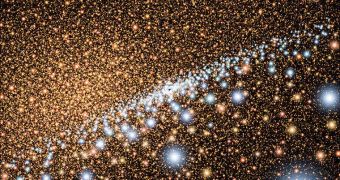I personally find it a bit peculiar that, lately, a lot of talk has been going on in the international astronomical community about the possible existence of life in other places in the Universe. Those rumors are about to get a new boost, as experts announce the discovery of what could very well be the fingerprint of large organic molecules in two galaxies other than the Milky Way.
Just a few years ago, the possible existence of extraterrestrial life was something to laugh about, and everyone arguing for this possibility was thought to be crazy. Right now, science is beginning to show that this may not be so far-fetched, at least in theory.
A lot of things came together to inform the current view on alien life, starting with the (somewhat controversial) discovery of microbes that can substitute phosphorus with arsenic in their DNA, and ending with the discovery of rocky exoplanets that orbit in the habitable zone of their parent stars.
Recently, a study demonstrated that it is possible for life to develop in any location where the basic conditions are met, a finding that no longer places our planet in a privileged position in the Cosmos.
Life may also exist on two moons in our solar system, Saturn's Enceladus and Jupiter's Europa, buried underneath thick ice sheets. Underneath miles of ice, conditions are similar to the environment beneath Antarctica, where various microorganisms have been found to thrive.
But things change when we consider a larger frame of reference. Our solar system may be special, in that it contains Earth, several other rocky worlds, icy moons and so on. Or it could be that the Milky Way is suited for supporting life altogether.
For those arguing that life exists elsewhere in the Universe as well, a new study completed by experts at NASA and in Europemay be a breath of fresh air. The research, which focused on finding the chemical fingerprints of large organic molecules in other galaxies, has turned up two hits.
The Andromeda Galaxy and the Triangulum Galaxy have both revealed the existence of what may very well be molecules containing 20 atoms or more. These chemicals are found by studying clues called diffuse interstellar bands (DIB), which telescopes can detect.
The investigation was coordinated by expert Martin Cordiner, who holds an appointment at the Center for Astrobiology at the NASA Goddard Space Flight Center (GSFC), in Greenbelt, Maryland.
He says that the DIB his team analyzed are a lot smaller than, say, a protein, but a lot more massive than some of the most common, naturally-occurring molecules that permeate space, such as carbon monoxide.
Topping off the list of potential chemical that may be yielding these clues are polycyclic aromatic hydrocarbons (PAH), substances common in the Universe, and that can be found in the Milky Way as well.
“We have studied DIB in incredibly diverse environments. Some have low levels of UV radiation. Some have radiation levels thousands of times higher,” Cordiner explains.
“Some have different amounts of 'ingredients' available for making stars and planets. And throughout all of these, we see DIB,” the expert goes on to say.
The reason why the discovery of organic molecules is so important is because they are largely made of carbon, a chemical that underlies life on Earth, and which can be found in the planet's atmosphere, oceans, crust, mantle and in its biosphere.
I also find it interesting that Andromeda, our closest large neighbor and a member of the Local Group, has lower levels of ultraviolet radiation, because it contains less young stars.
This is important because, if organic molecules are to have a chance to find a home where they can develop further, they need to be undamaged. In the Milky Way, life exists even if more UV radiation slam organic molecules than in Andromeda.
“But there are no detailed studies of Andromeda to tell us everything we want to know about conditions there. And even less is known about the Triangulum,” says Cordiner.
If we're going to understand fully how interstellar chemistry works – how stars and planets form, then we need a full understanding of the ingredients they use,” he adds.
One of the things that experts debate most about life here on Earth is where it came from. One side of the argument says that it emerged and developed here, whereas the other holds that comets and asteroids brought water and the key ingredients of life from space.
If the latter is indeed the case, then those molecules could have been taken from the same type of interstellar medium that is shared by Andromeda, Triangulum and the Milky Way. This is encouraging, because there are some differences between these three galaxies, especially in terms of chemistry.
Then, if this is the case, wouldn't it be reasonable to assume that those galaxies have the same chance of supporting the development of life as ours did? Would it be such a stretch to assume that that an exoplanet exists in Triangulum or Andromeda that fulfills the same conditions that Earth do?
If a rocky world that orbits its star in the habitable zone and has a liquid core that drives a magnetosphere exists, and is bombarded by comets carrying water-ice and organic molecules, could that planet not be seeded with the key elements of life like Earth did?
I believe the answer to this question is yes. The focus of the scientific debate should not be whether the emergence of life elsewhere in the Universe is possible or not, but if complex, intelligent extraterrestrial life can appear.
In my opinion, the chances of that happening are a lot slimmer than those of life finding a suitable planet to blossom on. A lot of things have to come together in order for that to happen, but all the recent science seems to be pointing in that general direction.

 14 DAY TRIAL //
14 DAY TRIAL //